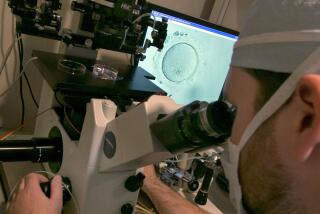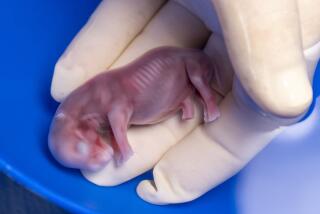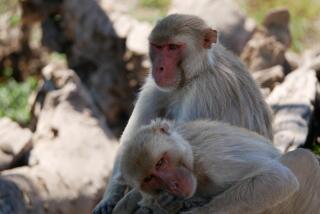Survivors of childhood cancers find hope for parenthood — in monkey testicles

Pitt researchers Kyle Orwig and Adetunji Fayomi outline their research advance in fertility preservation published in Science. (Credit: PittHealthSciences/UPMC)
Meet Grady, a spiky-haired miracle baby who could help children with cancer grow up to become parents.
This gregarious macaque enjoys snacking on nuts and catapulting herself off a bouncy-ball twice her size. In most respects, she is a normal infant monkey — which makes the circumstances of her birth all the more remarkable.
Grady’s father was subjected to chemotherapy when he was just 3 years old. The treatment sometimes causes infertility, so patients who receive it when they are too young to bank a sperm sample or freeze their eggs are often unable to have biological children.
But before Grady’s father got his chemo, researchers removed one of his testicles and stored the tissue on ice. After he reached puberty, the tissue samples were implanted under his skin, where they grew large enough to make sperm. Then all it took to produce Grady was standard in vitro fertilization, according to a study published Thursday in the journal Science.
Scientists are optimistic that the same approach could one day help young boys who undergo aggressive cancer treatments become fathers as well.
“The parents of a 10-year-old boy will often ask me what I can do for their kid, and until now, the answer is: nothing,” said Dr. Jesse Mills, a reproductive surgeon at UCLA who treats male infertility and was not involved in the research.
“So for me, this research is not a steppingstone — it’s a turning point. It’s going to reframe the conversation about a fulfilled life for kids after the cure.”
When an adult man is diagnosed with cancer, he can freeze his sperm before starting chemotherapy or radiation treatment and use it later in standard fertility treatments. But patients who have not yet reached puberty don’t have that option — they aren’t yet producing sperm.
Researchers estimate that about 30% of childhood cancer survivors will be infertile as adults. As the survival rate for childhood cancer increases, so does the number of former patients who can’t reproduce.
“This is a fairly new problem,” said Susan Taymans, who oversees fertility preservation work at the National Institute of Child Health and Human Development, which is part of the National Institutes of Health. “In the past, kids weren’t surviving cancer. Now, we can look past the baseline of, ‘Do you even live through it?’ and think about their quality of life down the road.”

Grady at play. (Credit: PittHealthSciences/UPMC)
In the new study, researchers set out to demonstrate that the childhood precursor to sperm — called spermatogonial stem cells — could be preserved as effectively as sperm itself.
The team, led by Kyle Orwig, a reproductive biologist at the University of Pittsburgh School of Medicine, removed one testis from five prepubertal macaques. Team members cut the tissue into small pieces — between 9 and 20 cubic millimeters — and froze it for about five months.
The monkeys didn’t have cancer, but their chemotherapy treatment simulated the experience of real cancer patients. Then the scientists thawed the preserved tissue samples and implanted them under the skin. Each monkey received grafts of his own tissue, both on his back and in his scrotum.
In order to judge the performance of the frozen tissue samples, the researchers also removed the remaining testis from the five macaques and implanted fresh testicular tissue alongside the preserved samples.
About four months later, Orwig received a visit from study co-author Karen Peters, a research employee who rarely interacted with him.
“She never talks to me, but she walked right into my office and said, ‘I have something you might want to see,’” Orwig recalled. ”I knew it was something spectacular.”
The minuscule grafts were growing. All 39 testicular tissue sites matured into large lumps and produced sperm over the course of a year. Some of the previously frozen grafts generated as many as 21 million sperm.
The underside of the skin has lots of tiny blood vessels, and researchers suspect that the injury caused by incisions and suturing needles may have enhanced sperm development by stimulating healing and prompting blood vessels to reach out to the grafts.
Sperm could be found regardless of whether the testicular tissue had been frozen or fresh. Nor did it matter whether the tissue was implanted in the back or the scrotum. (If the treatment works in humans, men could have their testicular tissue grafted to their upper arm or anywhere else, Taymans said.)
Orwig’s colleagues collected enough sperm from the once-frozen grafts to fertilize more than 130 macaque eggs. They transferred 11 embryos into six female monkeys, one of which had a successful pregnancy and gave birth to Grady.
Researchers have closely studied Grady’s behavior, including her playtime habits, social skills and even the amount of eye contact she has with her mother.
“She’s just a regular monkey, believe it or not,” Orwig said.
If the success in Pittsburgh can be repeated in other labs, human testing would “absolutely be the next logical step,” said Mills of UCLA. Human trials could be fairly non-invasive, using a small biopsy of just one quarter of a testicle, he said. (Orwig agreed that removing both testicles was unnecessary: “No, we’re not going to castrate the children.”)
“If I were a parent of a prepubescent child facing this diagnosis, I would be pretty quick to volunteer for something of this nature, to give him that possibility of fatherhood in the future,” he said. ”That’s something I wish I could offer these men that I’m now seeing at 30 or 35 years old.”
Further research is still needed to show that the technique would work with small biopsies that leave the testes intact, and that the testicular tissue left behind wouldn’t send hormonal signals that interfere with the graft’s function, Taymans said.
Another concern is that testicular tissue collected from children with blood cancers like leukemia and lymphoma could harbor malignant cancer cells, which could resurrect the disease years or even decades after patients were cured. As a result, the treatment may be limited to patients with cancers that have not spread to the testes, such as solid tumor sarcomas and neuroblastomas.
Orwig said he has already frozen testicular tissues for more than 200 human patients, hopeful that the therapy will be available when they are ready for fatherhood.
Peters, the research associate who burst into Orwig’s office with the early test results, now works as an oncology nurse at a University of Pittsburgh hospital.
“I’d love for her to be the one that one day walks into her patient’s room and says, ‘Let me hook you up with the fertility preservation people,’” he said.
“It’s easy for someone on the outside to say, ‘No big deal, you have to adopt.’ But when you look into the eyes of your patients, you know better.”







